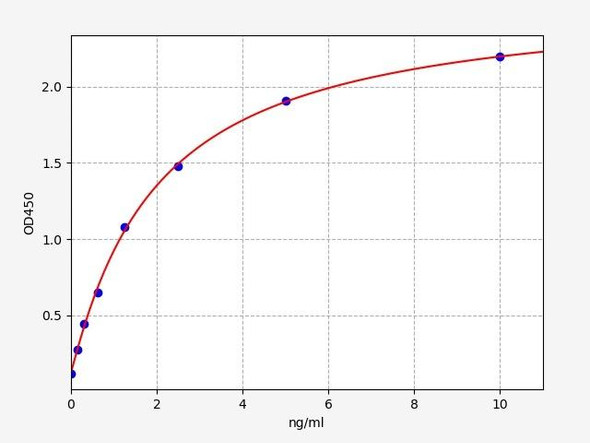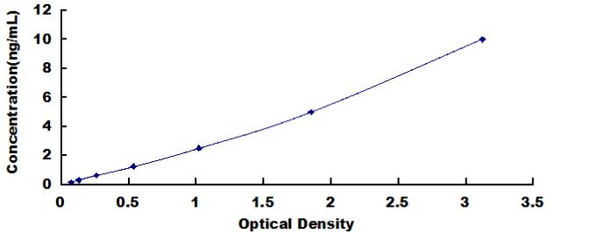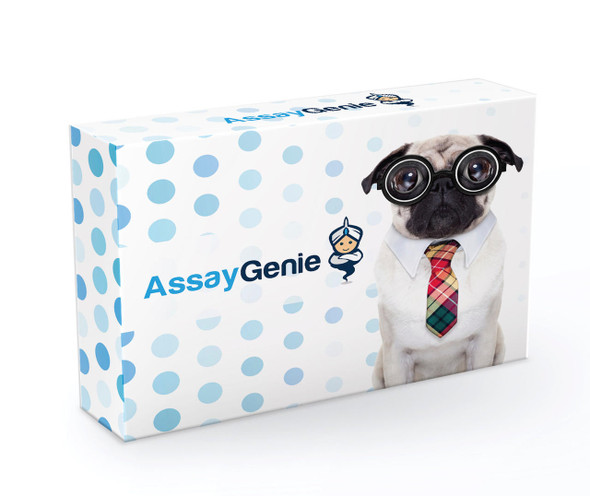Human Cell Cycle ELISA Kits 1
Human CENPF (Centromere Protein F) CLIA Kit (HUES00461)
- SKU:
- HUES00461
- Product Type:
- ELISA Kit
- ELISA Type:
- CLIA Kit
- Size:
- 96 Assays
- Sensitivity:
- 18.75pg/mL
- Range:
- 31.25-2000pg/mL
- ELISA Type:
- Sandwich
- Reactivity:
- Human
- Sample Type:
- Serum, plasma and other biological fluids
- Research Area:
- Cell Cycle
Description
| Assay type: | Sandwich |
| Format: | 96T |
| Assay time: | 4.5h |
| Reactivity: | Human |
| Detection method: | Chemiluminescence |
| Detection range: | 31.25-2000 pg/mL |
| Sensitivity: | 18.75 pg/mL |
| Sample volume: | 100µL |
| Sample type: | Serum, plasma and other biological fluids |
| Repeatability: | CV < 15% |
| Specificity: | This kit recognizes Human CENPF in samples. No significant cross-reactivity or interference between Human CENPF and analogues was observed. |
This kit uses Sandwich-CLIA as the method. The micro CLIA plate provided in this kit has been pre-coated with an antibody specific to Human CENPF. Standards or samples are added to the appropriate micro CLIA plate wells and combined with the specific antibody. Then a biotinylated detection antibody specific for Human CENPF and Avidin-Horseradish Peroxidase (HRP) conjugate are added to each micro plate well successively and incubated. Free components are washed away. The substrate solution is added to each well. Only those wells that contain Human CENPF, biotinylated detection antibody and Avidin-HRP conjugate will appear fluorescence. The Relative light unit (RLU) value is measured spectrophotometrically by the Chemiluminescence immunoassay analyzer. The RLU value is positively associated with the concentration of Human CENPF. The concentration of Human CENPF in the samples can be calculated by comparing the RLU of the samples to the standard curve.
| UniProt Protein Function: | CENPF: a nuclear matrix protein that assembles onto kinetochores at late G2. Is hyperphosphorylated during mitosis and rapidly degraded after mitosis. Involved in chromosome segregation during mitosis. Interacts with retinoblastoma protein (RB), CENP-E and BUBR1. Two alternatively spliced human isoforms have been described. |
| UniProt Protein Details: | Protein type:Nuclear envelope; Cell cycle regulation; Transcription, coactivator/corepressor Chromosomal Location of Human Ortholog: 1q41 Cellular Component: spindle pole; nuclear matrix; pronucleus; nuclear envelope; cytosol; kinetochore; nucleoplasm; perinuclear region of cytoplasm; cytoplasm; spindle; outer kinetochore of condensed chromosome; midbody; nucleus; chromatin; chromosome, pericentric region Molecular Function:protein C-terminus binding; dynein binding; protein binding; protein homodimerization activity; chromatin binding; transcription factor binding Biological Process: response to drug; mitosis; kinetochore assembly; muscle development; regulation of cell cycle; chromosome segregation; cell proliferation; protein transport; cell division; regulation of G2/M transition of mitotic cell cycle; mitotic cell cycle spindle assembly checkpoint; metaphase plate congression; mitotic cell cycle; G2/M transition of mitotic cell cycle; cell differentiation; negative regulation of transcription, DNA-dependent; regulation of striated muscle development Disease: Ciliary Dyskinesia, Primary, 31 |
| NCBI Summary: | This gene encodes a protein that associates with the centromere-kinetochore complex. The protein is a component of the nuclear matrix during the G2 phase of interphase. In late G2 the protein associates with the kinetochore and maintains this association through early anaphase. It localizes to the spindle midzone and the intracellular bridge in late anaphase and telophase, respectively, and is thought to be subsequently degraded. The localization of this protein suggests that it may play a role in chromosome segregation during mitotis. It is thought to form either a homodimer or heterodimer. Autoantibodies against this protein have been found in patients with cancer or graft versus host disease. [provided by RefSeq, Jul 2008] |
| UniProt Code: | P49454 |
| NCBI GenInfo Identifier: | 55770834 |
| NCBI Gene ID: | 1063 |
| NCBI Accession: | NP_057427. 3 |
| UniProt Secondary Accession: | P49454,Q13171, Q13246, Q5VVM7, |
| UniProt Related Accession: | P49454 |
| Molecular Weight: | 367,764 Da |
| NCBI Full Name: | centromere protein F |
| NCBI Synonym Full Names: | centromere protein F, 350/400kDa |
| NCBI Official Symbol: | CENPF |
| NCBI Official Synonym Symbols: | CENF; hcp-1; PRO1779 |
| NCBI Protein Information: | centromere protein F; mitosin; AH antigen; kinetochore protein CENPF; CENP-F kinetochore protein; cell-cycle-dependent 350K nuclear protein; centromere protein F, 350/400ka (mitosin); centromere protein F, 350/400kDa (mitosin) |
| UniProt Protein Name: | Centromere protein F |
| UniProt Synonym Protein Names: | AH antigen; Kinetochore protein CENPF; Mitosin |
| Protein Family: | Centromere protein |
| UniProt Gene Name: | CENPF |
| UniProt Entry Name: | CENPF_HUMAN |
As the RLU values of the standard curve may vary according to the conditions of the actual assay performance (e. g. operator, pipetting technique, washing technique or temperature effects), the operator should establish a standard curve for each test. Typical standard curve and data is provided below for reference only.
| Concentration (pg/mL) | RLU | Average | Corrected |
| 2000 | 51086 60356 | 55721 | 55693 |
| 1000 | 22087 25861 | 23974 | 23946 |
| 500 | 11114 10950 | 11032 | 11004 |
| 250 | 5108 5480 | 5294 | 5266 |
| 125 | 2681 2535 | 2608 | 2580 |
| 62.5 | 1362 1260 | 1311 | 1283 |
| 31.25 | 666 682 | 674 | 646 |
| 0 | 28 28 | 28 | -- |
Precision
Intra-assay Precision (Precision within an assay): 3 samples with low, mid range and high level Human CENPF were tested 20 times on one plate, respectively.
Inter-assay Precision (Precision between assays): 3 samples with low, mid range and high level Human CENPF were tested on 3 different plates, 20 replicates in each plate.
| Intra-assay Precision | Inter-assay Precision | |||||
| Sample | 1 | 2 | 3 | 1 | 2 | 3 |
| n | 20 | 20 | 20 | 20 | 20 | 20 |
| Mean (pg/mL) | 105.32 | 173.87 | 852.37 | 106.18 | 169.95 | 921.68 |
| Standard deviation | 12.43 | 13.13 | 59.07 | 11.38 | 14.24 | 60.55 |
| C V (%) | 11.80 | 7.55 | 6.93 | 10.72 | 8.38 | 6.57 |
Recovery
The recovery of Human CENPF spiked at three different levels in samples throughout the range of the assay was evaluated in various matrices.
| Sample Type | Range (%) | Average Recovery (%) |
| Serum (n=5) | 86-99 | 91 |
| EDTA plasma (n=5) | 86-96 | 91 |
| Cell culture media (n=5) | 97-109 | 103 |
Linearity
Samples were spiked with high concentrations of Human CENPF and diluted with Reference Standard & Sample Diluent to produce samples with values within the range of the assay.
| Serum (n=5) | EDTA plasma (n=5) | Cell culture media (n=5) | ||
| 1:2 | Range (%) | 86-100 | 92-103 | 88-100 |
| Average (%) | 93 | 98 | 93 | |
| 1:4 | Range (%) | 99-118 | 100-112 | 103-117 |
| Average (%) | 108 | 106 | 109 | |
| 1:8 | Range (%) | 97-113 | 92-107 | 93-108 |
| Average (%) | 105 | 100 | 101 | |
| 1:16 | Range (%) | 91-103 | 89-104 | 88-101 |
| Average (%) | 97 | 96 | 93 |
An unopened kit can be stored at 4°C for 1 month. If the kit is not used within 1 month, store the items separately according to the following conditions once the kit is received.
| Item | Specifications | Storage |
| Micro CLIA Plate(Dismountable) | 8 wells ×12 strips | -20°C, 6 months |
| Reference Standard | 2 vials | |
| Concentrated Biotinylated Detection Ab (100×) | 1 vial, 120 µL | |
| Concentrated HRP Conjugate (100×) | 1 vial, 120 µL | -20°C(shading light), 6 months |
| Reference Standard & Sample Diluent | 1 vial, 20 mL | 4°C, 6 months |
| Biotinylated Detection Ab Diluent | 1 vial, 14 mL | |
| HRP Conjugate Diluent | 1 vial, 14 mL | |
| Concentrated Wash Buffer (25×) | 1 vial, 30 mL | |
| Substrate Reagent A | 1 vial, 5 mL | 4°C (shading light) |
| Substrate Reagent B | 1 vial, 5 mL | 4°C (shading light) |
| Plate Sealer | 5 pieces | |
| Product Description | 1 copy | |
| Certificate of Analysis | 1 copy |
- Set standard, test sample and control (zero) wells on the pre-coated plate and record theirpositions. It is recommended to measure each standard and sample in duplicate. Note: addall solutions to the bottom of the plate wells while avoiding contact with the well walls. Ensuresolutions do not foam when adding to the wells.
- Aliquot 100µl of standard solutions into the standard wells.
- Add 100µl of Sample / Standard dilution buffer into the control (zero) well.
- Add 100µl of properly diluted sample (serum, plasma, tissue homogenates and otherbiological fluids. ) into test sample wells.
- Cover the plate with the sealer provided in the kit and incubate for 90 min at 37°C.
- Aspirate the liquid from each well, do not wash. Immediately add 100µL of BiotinylatedDetection Ab working solution to each well. Cover the plate with a plate seal and gently mix. Incubate for 1 hour at 37°C.
- Aspirate or decant the solution from the plate and add 350µL of wash buffer to each welland incubate for 1-2 minutes at room temperature. Aspirate the solution from each well andclap the plate on absorbent filter paper to dry. Repeat this process 3 times. Note: a microplatewasher can be used in this step and other wash steps.
- Add 100µL of HRP Conjugate working solution to each well. Cover with a plate seal andincubate for 30 min at 37°C.
- Aspirate or decant the solution from each well. Repeat the wash process for five times asconducted in step 7.
- Add 100µL of Substrate mixture solution to each well. Cover with a new plate seal andincubate for no more than 5 min at 37°C. Protect the plate from light.
- Determine the RLU value of each well immediately.






